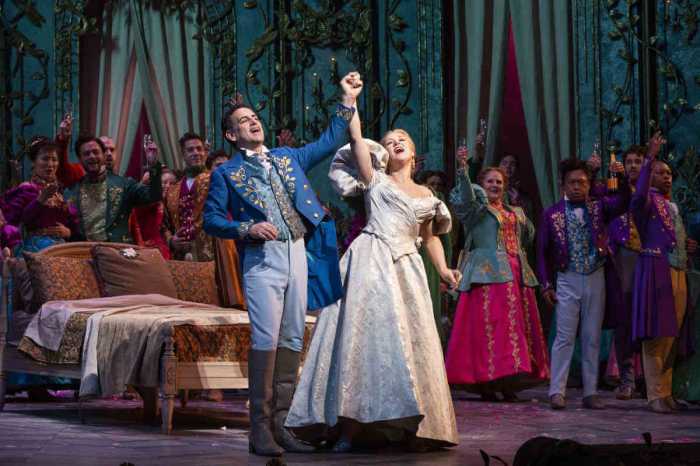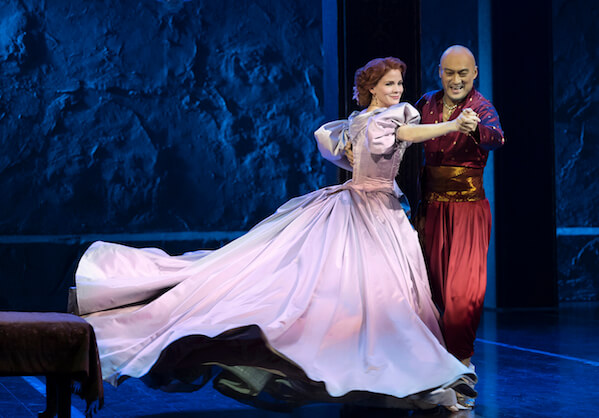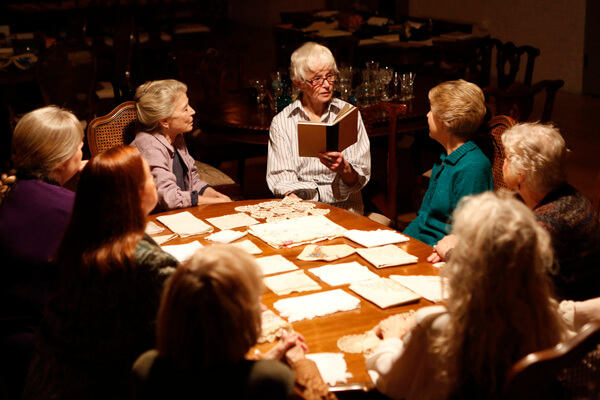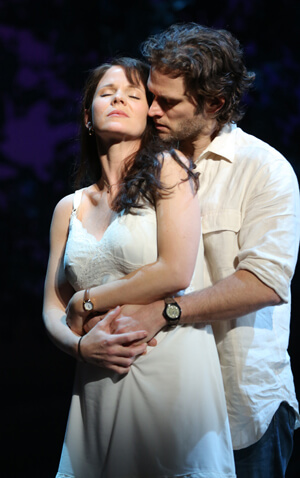Diana Damrau and Vittorio Grigolo in Bartlett Sher’s staging of the Charles Gounod’s “Roméo et Juliette” at the Met. |KEN HOWARD/ METROPOLITAN OPERA
Passionate women who go to extreme lengths for love eventually making the ultimate sacrifice are the lifeblood of opera. The winter opera season brought us several shattering portraits of women who live and die for love.
Only a few hours before 2017 began, Juliet Capulet died for love in the New Year’s Eve Gala premiere of the Metropolitan Opera’s new production of Gounod’s “Roméo et Juliette.” When I say “new production,” it is somewhat misleading since Bartlett Sher’s staging has already been seen at Salzburg, La Scala, and the Lyric Opera of Chicago. Sher doesn’t go for anything too intellectually sophisticated here –– but then neither does Charles Gounod!
Michael Yeargan’s handsome realistic unit set surrounds the stage with carved stone building façades. Multi-level tiers of arched doorways with balconies surround a large open central courtyard where most of the action takes place. The unit set can be redressed, which eliminates stage waits for scene changes, and there is only one intermission after the wedding scene.
Vittorio Grigolo, Diana Damrau impulsive, impassioned young lovers in Met’s “Roméo et Juliette”
The action has been updated to the 18th century, evoking Casanova’s Venice in carnival season with sumptuously detailed period costumes by Catherine Zuber. Since Gounod’s score sounds more 19th century France than early Renaissance Verona, this allows the drama and the music to meet halfway in a sensible compromise. The wide frame, outdoor unit set works reasonably well in the first half for the Capulet ballroom and especially well for the Balcony Scene and the street duels (excitingly staged by B.H. Barry) in the Verona town square.
In the second half, the wide open space fails to provide intimacy for Juliet’s bedchamber –– the large white drapery could have been suspended as a kind of pavilion rather than used as a gigantic bed linen. Juliet wraps herself in this white drop as a kind of wedding dress/ winding sheet for her faked “death” scene, and then she seems to revive and zombie-walk into her own tomb. It would have been more convincing if she had been carried unconscious by supers on a litter. The unit set is scarcely better adapted to the Capulet tomb.
Gounod’s adaptation of the Shakespeare tragedy has been described as one big love duet. Two charismatic leads with romantic chemistry can rescue any production of “Roméo et Juliette.” The Metropolitan Opera provided just such a pair. Vittorio Grigolo certainly possesses the Italianate good looks for Roméo, and his lean bright tenor that blossoms on top suits the French repertory. Even Grigolo’s vocal mannerisms, so unsettling in Italian opera, actually work here. The quivering vibrato, hint of pop croon in the middle register, and “hooking” into high notes sound stylish rather than alien. He capped the Act III duel scene ensemble with a ringing high C. As an actor, Grigolo has almost too much temperament but his excitability and tendency to overact register as teenage exuberance, naiveté, and Latin bravado. This Romeo climbs up the wall to Juliet’s balcony, and we love him for it.
Diana Damrau, in another role debut at the Metropolitan Opera, is an equally impulsive Juliette hurling herself headlong into passion and death. Damrau counteracts her own physical and vocal maturity with high-energy acting that borders on hyperactivity –– lots of dashing around the stage, head bobbing, and frenetic gestures. Grigolo and Damrau share the same manic energy, seem magnetized toward each other, and have to be forcibly separated in the wedding scene.
Damrau’s Juliette is artistically finished with excellent French diction, musicianship, and style. I wish her vocalism had been on the same level. The coloratura of her Act I entrance and waltz song had a hard edge with effortful high notes. The more lyrical sections in later acts were marred by hollow tone with only occasional glints of silvery beauty. I hope this is due to a lingering indisposition and not vocal decline –– Damrau had canceled her December 10 recital due to bronchitis. As a partnership, Grigolo and Damrau are greater than the sum of their individual performances.
The rest of the cast was a mixed bag. Handsome in stage presence and baritone voice, Elliot Madore’s Mercutio was a blank cipher. Diego Silva’s slim tenor made for an unthreatening Tybalt. Virginie Verrez looked and sounded nervy and darkly attractive in the trouser role of Stéphano. Mikhail Petrenko’s grainy, shallow light bass was barely adequate to Frère Laurent. Laurent Naouri sang a suavely idiomatic Capulet.
Maestro Gianandrea Noseda gave a passionate reading of the score that balanced lyrical sweetness and symphonic grandeur with dramatically propulsive tempos.
Sher’s production will return in March with two younger, less experienced leads –– Stephen Costello and Pretty Yende. We will see if Sher’s production is just a handsome, sensibly staged backdrop for star performers or has the dramatic integrity to propel two new star-crossed lovers into creating star-making performances of their own. They will have a tough act to follow.
“Roméo et Juliette” will be transmitted live in HD at 12:55 pm on January 21 (metopera.org/Season/In-Cinemas).
At the 2017 Prototype Festival, the price of love was too high for the abused heroines of Missy Mazzoli and Royce Vavrek’s “Breaking the Waves” and Matt Marks and Paul Peers’ world premiere “Mata Hari”.
Kiera Duffy and John Moore in Missy Mazzoli and Royce Vavrek’s “Breaking the Waves.” | NICHOLAS KORKOS / OPERA PHILADELPHIA
Missy Mazzoli’s “Breaking the Waves” is adapted from the 1996 film by Lars von Trier revolving around a deeply religious, mentally troubled young woman, Bess McNeill. Bess, who was brought up in an intensely religious Calvinist community on the isle of Skye off the coast of Scotland, marries Jan, an atheist Norwegian oil worker, who initiates Bess into the joys of sex and love. When the newlyweds are separated by Jan’s work on the oil rig, Bess prays to God that Jan come home and never leave her again. Her wish is cruelly granted when an accident on the rig robs Jan of his physical abilities, rendering him a hospital-bound invalid fighting for his life.
Jan advises the emotionally impressionable Bess, who blames herself for his accident, to have sex with other men and tell him about it – that way he can live through her physical experiences. Bess resists initially but when Jan’s condition worsens she sexually experiments with random strangers and Jan seems to improve. Bess sacrifices her body, religious beliefs, morals, and mental well-being to restore her husband, ultimately sacrificing herself but not her love.
Mazzoli proves herself in her first full-length opera to be a natural operatic composer – her music speaks in intensely expressive terms on the human experience. Many classical musicians approach opera like aliens forced to compose poetry in a foreign language – the syntax is tortured, the emphases misplaced, and the accents forced and false. Mazzoli is a native speaker in opera, communicating directly to the audience. All of her extensive technical resources are focused at expressing the characters’ emotions and the dramatic atmosphere of the story.
The vocal writing is well-crafted to the voice and fits the text – 95 percent of the words were intelligible without looking at the surtitles. Musically her style initially reminded me of Britten – “Peter Grimes” and “The Turn of the Screw,” in particular – but her adventurous harmonic and orchestral effects put me in mind of Stravinsky. Yet Mazzoli has already found her own voice in “Breaking the Waves,” and it is strong and confident. Vavrek’s libretto is concise and moving and also never hits a false note, keeping the language colloquial yet powerful in its simplicity.
The New York premiere at NYU’s Skirball Center for the Performing Arts is a co-production with Opera Philadelphia (where Mazzoli was finishing her stint as composer in residence when “Breaking the Waves” had its triumphant world premiere this past September) and Beth Morrison Projects, which presented it at this year’s Prototype Festival. James Darrah’s production shrewdly creates a varied sense of external and internal space on Adam Rigg’s unit set of jagged platforms suggesting a rough rocky landscape with evocative projections by Adam Larsen.
Soprano Kiera Duffy displays shattering bravery in the central role of Bess, who is hardly ever offstage during the two-hour playing time. Duffy’s Bess has to be physically and emotionally naked and go from guttural declamation to high soprano vocalises in her tortured internal monologues. Not a false note emerges from Duffy all evening long, either vocally or dramatically. Her slender, pure high soprano shows surprising sturdiness and depth over a punishing evening.
Baritone John Moore brings a naturally radiant stage presence to Jan with his electric eyes and dazzling smile – once can understand the effect he has on Bess. Moore is also required to shed clothing and spends the majority of the evening a silent figure center stage lying flat on his back on a hospital bed. Jan is ever present in the audience’s consciousness as he is in Bess’ mind.
Eve Gigliotti’s warm, creamy mezzo captured the loving, unswerving loyalty of Bess’ protective sister-in-law, Dodo, rising to heights of righteous anger in Act II. Strong, vivid supporting turns by Theodora Hanslowe, Dominic Armstrong, Marcus DeLoach, and Matthew Curran provided a strong sense of the community that Bess must contend with. Julian Wachner, known hereabouts for his baroque music work at Trinity Church downtown, led an accomplished group of local musicians in a vibrant, authoritative reading of Mazzoli’s score. Meanwhile, several opera companies here and abroad are discussing further productions of “Breaking the Waves”, and Mazzoli and Vavrek are collaborating on their next operatic commission.
Tina Mitchell in Matt Marks and Paul Peers’ “Mata Hari.” | BENJAMIN HELLER/
Matt Marks and Paul Peers’ interdisciplinary opera-theater piece “Mata Hari” is a world premiere co-production with HERE. The story is inspired by the life of Mata Hari, the Dutch-born exotic dancer and courtesan who was executed for espionage during World War I. Librettist/ director Peers focuses on Mata Hari during last months of her life while incarcerated in Saint-Lazare prison in Paris. Flashbacks focus on her relationships with the five men that lead to her execution in 1917. Mata Hari is a spoken role while her erstwhile lovers, confessors, tormentors, betrayers, and inquisitors are through-composed sung roles. Marks’ eclectic score has elements of cabaret art song backed by four-piece electro-acoustic instrumentation.
Mata Hari was born Margaretha Zelle in Holland and emigrated to the Dutch East Indies as the mail order bride of an older alcoholic military officer, Captain Rudolf MacLeod. MacLeod’s infidelities and brutality drove the young Margreet into the arms of other men but not before infecting her with syphilis, which she passed in utero onto their two young children. Inept military doctors poisoned their son Norman with overdoses of medicinal mercury, and Margreet lost custody of their daughter Louise. Having studied oriental dance in the East Indies, Margreet reinvented herself as Mata Hari (“eye of the dawn”), an exotic dancer conquering the variety stages of Europe and seducing the Parisian demi-monde with her sensual movements and revealing costumes.
By 1914, Hari was approaching 40 and turned to espionage to financially supplement a fading dancing career and an uncertain future as a courtesan. No one will know where the Dutch citizen’s true national sympathies lay – Hari claimed loyalty to her adopted France and she may have only accepted money from the Germans without divulging sensitive information. The one man she truly loved was wounded Russian officer Vadim Maslov, who spurned her after she was denounced as a traitor and spy. A lack of serious training probably caused Mata Hari to reveal herself as a double agent to the Germans, who may have compromised her to the French War Ministry. But this was enough for the French who sentenced her to death by firing squad.
Peers’ direction is fluid and swift using sheer curtains with video projections to expand or contract the stage space. Actress Tina Mitchell is a fiercely manipulative, defensive and eventually desperate Mata Hari. This Mata Hari is less the femme fatale seductress and more the victim of military men, from her husband to her various French and German lovers and spy masters down to the firing squad that executed her. Soprano Mary MacKenzie sang strongly as Sister Léonide, who initially despises Mata Hari but becomes her defender and supporter at the end. The various men are sung in different vocal disciplines by Jeffrey Gavett, Daniel Neer, Steve Hrycelak, Tomás Cruz, and operatic baritone Joshua Jeremiah. The 85-minute chamber music theater piece proved a flawed but compelling portrait of a woman who reinvented herself by breaking society’s rules and renouncing personal loyalties – in the end, male-dominated society took its revenge.





































